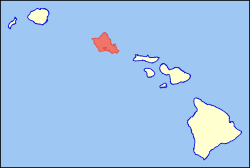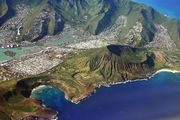Oahu
| Oʻahu | |
|---|---|
| The Gathering Place | |
.jpg) Satellite photo of Oʻahu |
|
 Location in the state of Hawaii. |
|
| Geography | |
| Area | 596.7 sq. mi. (1,545.4 km²) |
| Rank | 3rd largest Hawaiian Island |
| Highest point | Mount Kaʻala |
| Max elevation | 4,003 ft (1,220.1 m) |
| Demographics | |
| Population | 905,034 (as of 2008[1]) |
| Density | 1,468/sq. mi. (567/km²) |
| Official Insignia | |
| Flower | Ilima |
| Color | Melemele (yellow) |
Oahu (pronounced /oʊˈɑːhuː/ in English) or Oʻahu (pronounced [oˈʔɐhu] in Hawaiian), known as "The Gathering Place", is the third largest of the Hawaiian Islands and most populous of the islands in the State of Hawaiʻi. The state capital Honolulu is located on the southeast coast. Including small close-in offshore islands such as Ford Island and the islands in Kaneohe Bay and off the eastern (windward) coast, it has a total land area of 596.7 square miles (1,545.4 km2), making it the 20th largest island in the United States.[2] In greatest dimension, this volcanic island is 44 miles (71 km) long and 30 miles (48 km) across. The length of the shoreline is 227 miles (365 km). The island is the result of two separate shield volcanoes: Waiʻanae and Koʻolau, with a broad "valley" or saddle (the central Oʻahu Plain) between them. The highest point is Mt. Ka'ala in the Waiʻanae Range, rising to 4,003 feet (1,220 m) above sea level.[3]
Contents |
Introduction



The island is home to about 902,168 people (approximately 75% of the resident population of the state, with approximately 75% of those living on the "city" side of the island). Oʻahu has for a long time been known as "The Gathering Place". However, the term Oʻahu has no confirmed meaning in Hawaiian, other than that of the place itself.[4] Ancient Hawaiian tradition attributes the name's origin in the legend of Hawaiʻiloa, the Polynesian navigator credited with discovery of the Hawaiian Islands. The story relates that he named the island after a son.
Residents of O'ahu refer to themselves as "locals" (as done throughout Hawai'i), no matter their ancestry.
The city of Honolulu—largest city, state capital, and main deepwater marine port for the State of Hawaiʻi—is located here. As a jurisdictional unit, the entire island of Oʻahu is in the City & County of Honolulu, although as a place name, Honolulu occupies only a portion of the southeast end of the island (essentially, the Honolulu District).
Well-known features found on Oʻahu include Waikīkī, Pearl Harbor, Diamond Head, Hanauma, Kāneʻohe Bay, Kailua Bay, North Shore.
Being roughly diamond-shaped, surrounded by ocean and divided by mountain ranges, directions on O'ahu are not generally described with the compass directions found throughout the world. Locals instead use "ewa" (pronounced "eh-va") to mean toward the western tip of the island, "Diamond Head" to be toward the eastern tip, "mauka" is toward the mountains and "makai" toward the sea.
Locals consider the island to be divided into various areas, which may overlap. The most commonly-accepted areas are the "City" or "Town side", which is the metropolitan area from Mililani to the area below Diamond Head (residents of the island north of the Ko'olau Mountains consider the City Side to be the entire southern half); "West O'ahu," which goes from Pearl Harbor to Haleiwa; the "North Shore" (northwestern coast); the "Windward Side" (northeastern coast); the "East Coast" (the eastern portion of the island, including both the Windward Side and the area east of Diamond Head; and "The Valley," which runs northeast from Pearl Harbor toward Haleiwa. These terms are somewhat flexible, depending on the area in which the user lives, and are used in a mostly general way.
History


The old Kingdom of Oʻahu was once ruled by the most ancient Aliʻi in all of the Hawaiian Islands. The first great king of Oʻahu was Mailikukahi, the law maker, who was followed by many generation of monarchs. Kualii was the first of the warlike kings and so were his sons. In 1773, the throne fell upon Kahahana, the son of Elani of Ewa. In 1783 Kahekili II, King of Maui, conquered Oʻahu and deposed the reigning family and then made his son Kalanikupule king of Oʻahu. Kamehameha the Great would conquer in the mountain Kalanikupule's force in the Battle of Nuʻuanu. Kamehameha founded the Kingdom of Hawaiʻi with the conquest of Oʻahu in 1795. Hawaiʻi would not be unified until the islands of Kauaʻi and Niʻihau surrendered under King Kaumualii in 1810. Kamehameha III moved his capital from Lāhainā, on Maui to Honolulu, Oʻahu in 1845. ʻIolani Palace, built later by other members of the royal family, is still standing, and is the only royal palace on American soil.
Oʻahu was apparently the first of the Hawaiian Islands sighted by the crew of HMS Resolution on 18 January 1778 during Captain James Cook's third Pacific expedition. Escorted by HMS Discovery, the expedition was surprised to find high islands this far north in the central Pacific. Oʻahu was not actually visited by Europeans until 28 February 1779 when Captain Charles Clerke aboard HMS Resolution stepped ashore at Waimea Bay. Clerke had taken command of the ship after Capt. Cook was killed at Kealakekua Bay (island of Hawaiʻi) on February 14, and was leaving the islands for the North Pacific.

The opening battle of World War II in the Pacific for the United States was the Imperial Japanese Navy attack on Pearl Harbor, Oʻahu on the morning of December 7, 1941. The surprise attack was aimed at the Pacific Fleet of the United States Navy and its defending Army Air Corps and Marine Air Forces. The attack damaged or destroyed twelve American warships, destroyed 188 aircraft, and resulted in the deaths of 2,403 American servicemen and 68 civilians (of those, 1,177 were the result of the destruction of the USS Arizona alone).
Today, Oʻahu has become a tourism and shopping haven as over five million visitors (mainly from the American mainland and Japan) flock there every year to enjoy the quintessential island holiday experience that the Hawaiian Islands and their multicultural people now personify.
An earthquake, measuring 6.7 on the Richter scale, struck the Island Of Hawai'i and the surrounding islands at 07:07:49 HST on 15 October 2006, causing an island-wide power outage and over $200 million in damages.
Tourist attractions



Top beaches
- Ala Moana Beach
- Hanauma Bay
- Kailua Beach
- Kaneohe Bay
- Lanikai Beach
- Sandy Beach
- Sunset Beach
- Waikīkī Beach
- Waimanalo Beach
- Waimea Bay
Attractions
- Ala Moana
- Aloha Tower
- Bernice P. Bishop Museum
- Diamond Head
- Disney's Aulani Resort
- Honolulu
- Honolulu Academy of Arts
- Mauna Ala
- North Shore
- Pali Lookout
- Pearl Harbor
- Polynesian Cultural Center
- USS Arizona Memorial
- USS Missouri
- Valley of the Temples
- Waikīkī
Oahu in media
Oʻahu has been featured in many movies and television shows, including, but not limited to: Blue Crush, Lost, Dante's Cove, 50 First Dates, Flight 29 Down, Forgetting Sarah Marshall, From Here to Eternity (movie), From Here to Eternity (TV series), Hawaii Five-O, Jake and the Fatman, the Jurassic Park movies, The Karate Kid, Part II, Magnum, P.I., Mighty Joe Young, North Shore, Pearl Harbor, Tora! Tora! Tora!, and Windtalkers. The Disney Channel movie Johnny Tsunami as well as its sequel, Johnny Kapahala, use Oahu as the hometown of the family. The Even Stevens Movie, also by Disney, was filmed in various locations on O'ahu. The reality TV show Dog the Bounty Hunter is filmed in the regions of Honolulu, Oʻahu (as well as other regions in Oʻahu), and the city of Kailua-Kona on the Big Island of Hawaiʻi. The children's series Flight 29 Down was filmed on the island. The hit television series Lost was also filmed on Oahu, and many of the show's stars still call the island home. The island's thick rainforests and picturesque beaches are prominently featured. The ABC TV show Hawaiian Eye, while set in Hawaii, was filmed in Los Angeles.
Multiplayer online racing game Test Drive Unlimited takes place on a fully modeled Oʻahu island with 1,000 miles (1,600 km) of roads and highways. It has been confirmed that Oʻahu will be featured in its sequel, Test Drive Unlimited 2, as a second island, together with Ibiza.
Notes
- ↑ Census.gov
- ↑ "Table 5.08 - Land Area of Islands: 2000" (PDF). 2004 State of Hawaii Data Book. State of Hawaii. 2004. http://www.hawaii.gov/dbedt/info/economic/databook/db2004/section05.pdf. Retrieved 2007-07-23.
- ↑ "Table 5.11 - Elevations of Major Summits" (PDF). 2004 State of Hawaii Data Book. State of Hawaii. 2004. http://www.hawaii.gov/dbedt/info/economic/databook/db2004/section05.pdf. Retrieved 2007-07-23.
- ↑ Pukui, et al., 1976
References
- ↑ Census.gov
- ↑ "Table 5.08 - Land Area of Islands: 2000" (PDF). 2004 State of Hawaii Data Book. State of Hawaii. 2004. http://www.hawaii.gov/dbedt/info/economic/databook/db2004/section05.pdf. Retrieved 2007-07-23.
- ↑ "Table 5.11 - Elevations of Major Summits" (PDF). 2004 State of Hawaii Data Book. State of Hawaii. 2004. http://www.hawaii.gov/dbedt/info/economic/databook/db2004/section05.pdf. Retrieved 2007-07-23.
- ↑ Pukui, et al., 1976
- Macdonald, Gordon A., Agatin T. Abbott, and Frank L. Peterson. 1983. Volcanoes in the Sea. University of Hawaiʻi Press, Honolulu. 517 pp.
- Pukui, M.K., S.H. Elbert, and E.T. Mookini. 1976. Place names of Hawaiʻi. University of Hawaiʻi Press. 289 pp.
External links
- Oahu travel guide from Wikitravel
- OahuwithKids
- A history of Oahu's Harbors
- Oahu information guide
|
||||||||||||||
|
||||||||||||||||||||
